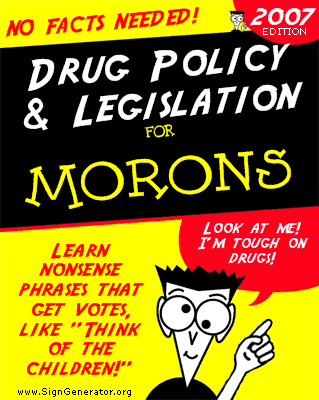
By Jill Chapin
March 30, 2009
President Obama recently responded in the negative to a query on whether it’s time to legalize marijuana. Being a smart, rational guy, I guess he knew better than to rock his political boat by giving credence to such an outside-the-box solution as the decriminalization of marijuana.
By anyone’s standards though, our supposed war on drugs is a massive failure, a colossal waste of taxpayer money, and is actually escalating drug violence on our Mexican border with American guns and money flowing south while drugs come flooding north.
For this very reason, even Secretary of State Hillary Clinton recently had the good sense to admit that the U.S. bears some responsibility for the escalating drug violence in Mexico. She also admitted that the war on drugs has not been successful. But instead of taking the high road on the issue of her countrymen getting high, she instead offered nothing more than basically more of the same.
Her so-called solution is the very definition of insanity, whereby you keep doing the same thing over and over, hoping for a different result.
She should have noted her predecessor’s philosophy of knowing when to hold them or fold them. Former Secretary of State Condoleeza Rice related the story of how she wanted to be a major concert pianist and how she studied piano from the tender age of three, even majoring in music for a while. When she went off to a music festival and met 12-year-olds who could play from sight, that had taken her years to learn, she came to grips with the reality that, although she might play at Nordstroms, she’d never play Carnegie Hall.
Why are Americans so averse to changing course regarding a new approach to our drug problem? Why not entertain the idea of slowly dismantling our archaic drug laws – perhaps as a trial run for a few years – and just see what happens?
We put a man on the moon. Can’t we come up with a safe and sensible way of responsibly selling marijuana? We sell alcohol and cigarettes, two deadly killers, and yet we seem comfortable with their distribution methods, even though it’s easier for kids to buy a six pack or a carton than it is for them to get their hands on Sudafed.
Why are we falling for the fallacy-filled excuse that we don’t want our pilots or bus drivers under the influence of marijuana? Of course we don’t. And we also don’t want them under the influence of legalized drugs either, which have proven deadly when operating a vehicle.
Dangers lurk everywhere in life, but we can be sensible about coping with them. Marijuana is not nearly as scary as violent drug dealers who create mayhem on our streets, who deal with megabucks that further fuel their purchase of more deadly guns. We need to stop and think — really think – about how best to de-escalate the myriad problems that have been created – not solved – by our current war on drugs.
If adults choose to abuse the use of marijuana, we need to allow them the freedom to do so, just as we already do with their freedom to abuse alcohol and tobacco.
We also should be less naive about our children. They are already quite savvy in getting whatever they want whenever they want. But they are getting it in unsavory places from unsavory people, paying outrageous prices. How long would those pushers stay in business if they knew that the dope they sell could be legally undersold at a fraction of their price?
We need to look in another direction if we are to have any hope of addressing drug use in our country. If a non-user grandmother like myself can entertain the possibility of legalizing marijuana, maybe you can too. We just need to be brave in taking the first step toward imagining a world where draconian laws, incarceration, fear and ridicule may not be the only answers out there.


 The Hunger Site
The Hunger Site
March 31, 2009 at 2:03 pm
In 2006, Marijuana was the largest cash crop in the United States, more valuable than corn and wheat combined. Using conservative price estimates domestic marijuana production has a value of $35.8 billion. Based on production estimates derived from marijuana eradication efforts from 2003 to
2005, marijuana is the top cash crop in 12 states, one of the top 3 cash crops in 30 states, and one of the top 5 cash crops in 39 states. For example, the domestic marijuana crop was larger than grapes, vegetables and hay combined in California. As long as there is a demand for illicit drugs, there will be a supply. Why not legalize marijuana and tax this crop. That way we satisfy the demand for marijuana locally, tax it and by doing so take away the “king crop” from the Mexican drug cartels? Not likely in the near future.